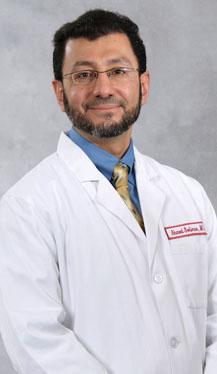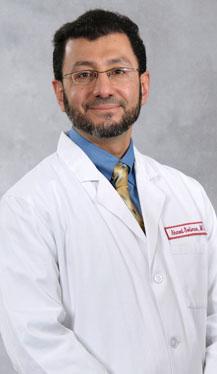
Credit: Lewis Katz School of Medicine at Temple University
(Philadelphia, PA) – Endotracheal intubation, in which a tube is inserted through the voice box (larynx) into the windpipe, and tracheotomy, in which surgery is undertaken to create a hole through the neck and into the windpipe (trachea) to facilitate breathing, are widely used in the hospital setting for elective surgery and in cases of serious illness or critical injury. In rare instances, however, the procedures result in the development of scarring and narrowing of the larynx and trachea, a condition known as acquired laryngotracheal stenosis (ALTS). Who is susceptible to ALTS – and why – is unclear, but according to new research at the Lewis Katz School of Medicine (LKSOM) at Temple University, genetic and ethnic background may be underlying factors.
"Many efforts have been made to decrease the risk of laryngeal and tracheal scarring through improved materials and techniques," explained Ahmed M.S. Soliman, MD, Professor and Interim Chair of Otolaryngology – Head and Neck Surgery; Director of the Voice, Airway, and Swallowing Center at LKSOM; and senior investigator on the new study. "Still, some patients develop ALTS, and now we realize that genetic differences, specifically those occurring in certain wound-healing genes, may put some patients at greater risk." The new study was published November 22 in the journal Laryngoscope.
ALTS affects an estimated one to eight percent of patients who have an endotracheal or tracheotomy tube placed. While the condition is rarely fatal, patients can develop difficulty breathing, necessitating complex emergency surgery to open the airway. It can also lead to voice and swallowing dysfunction. In some cases, patients require permanent tracheotomy.
"Our hypothesis was that aberrations in wound healing, which are observed in patients with other scarring disorders, are related to ALTS," Dr. Soliman said. Knowing this, Dr. Soliman and colleagues decided to search the DNA of ALTS patients for specific changes in genes associated with scarring and wound healing.
A total of 138 patients were recruited from Temple University Hospital and its associated clinics for the study. Fifty-three of the recruits had ALTS, while the remainder of the patients were controls, individuals who had undergone endotracheal intubation or tracheotomy without scarring. DNA was isolated from each patient's blood and analyzed for the presence of any of six candidate genetic variations in a panel of scar formation and wound-healing genes.
Although none of the overall candidate variations was significantly associated with ALTS, when Dr. Soliman and colleagues carried out subgroup analyses, they found that certain variants were in fact significantly linked to ALTS, depending on ethnic background. The association with stenosis was high particularly for African Americans.
While the findings are preliminary, they pave the way for someday preventing ALTS through genetic testing. "If we know someone is at risk for developing ALTS, we could use alternatives to breathing tubes or use the tubes for only a short period of time, decreasing the chance of scar formation," Dr. Soliman said.
In the near-term, the next step is to confirm the new findings in a larger study, involving about 300 study patients. A multi-institutional trial would likely be needed to obtain this number. Such a large pool of patient data would greatly facilitate research on ALTS and open new avenues of study into genetic aspects of other forms of laryngotracheal stenosis.
"We are particularly interested in using the techniques that we developed to study the genetics of idiopathic stenosis, which has no known cause," Dr. Soliman explained. "The idiopathic condition occurs almost exclusively in women of Northern European descent, suggesting the existence of additional associations between laryngotracheal stenosis and genetic and ethnic background."
###
Other investigators contributing to the new study include Mursalin M. Anis, the Department of Otolaryngology-Head and Neck Surgery at LKSOM and Coastal Ear, Nose and Throat, Neptune, New Jersey; Evgeny Krynetskiy and Natalia Krynetskaia, the Department of Pharmaceutical Sciences at the Temple University School of Pharmacy; and Zhigen Zhao, the Department of Statistics, Fox School of Business, Temple University.
The research was supported in part by an investigator-initiated research grant from Acclarent, Inc. (IIS: A-007).
About Temple Health
Temple University Health System (TUHS) is a $1.8 billion academic health system dedicated to providing access to quality patient care and supporting excellence in medical education and research. The Health System consists of Temple University Hospital (TUH), ranked among the "Best Hospitals" in the region by U.S. News & World Report; TUH-Episcopal Campus; TUH-Northeastern Campus; Fox Chase Cancer Center, an NCI-designated comprehensive cancer center; Jeanes Hospital, a community-based hospital offering medical, surgical and emergency services; Temple Transport Team, a ground and air-ambulance company; and Temple Physicians, Inc., a network of community-based specialty and primary-care physician practices. TUHS is affiliated with the Lewis Katz School of Medicine at Temple University, and Temple University Physicians, which is Temple Health's physician practice plan comprised of more than 500 full-time and part-time academic physicians in 20 clinical departments.
The Lewis Katz School of Medicine (LKSOM), established in 1901, is one of the nation's leading medical schools. Each year, the School of Medicine educates approximately 840 medical students and 140 graduate students. Based on its level of funding from the National Institutes of Health, the Katz School of Medicine is the second-highest ranked medical school in Philadelphia and the third-highest in the Commonwealth of Pennsylvania. According to U.S. News & World Report, LKSOM is among the top 10 most applied-to medical schools in the nation.
Temple Health refers to the health, education and research activities carried out by the affiliates of Temple University Health System (TUHS) and by the Katz School of Medicine. TUHS neither provides nor controls the provision of health care. All health care is provided by its member organizations or independent health care providers affiliated with TUHS member organizations. Each TUHS member organization is owned and operated pursuant to its governing documents.
Media Contact
Jeremy Walter
[email protected]
267-838-0398
@TempleHealthMed
http://www.templehealth.org/
Original Source
https://www.templehealth.org/News/TempleResearchersIdentifyGeneticFactorsLinkedtobrAcquiredNarrowingoftheAirway?id=3247&showBack=true&PageIndex=0&cid=13





